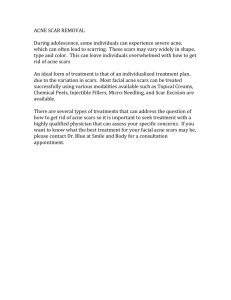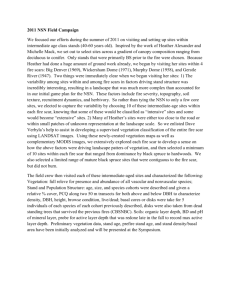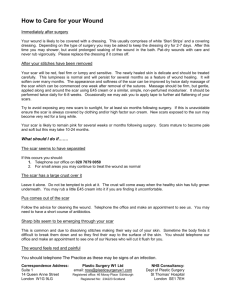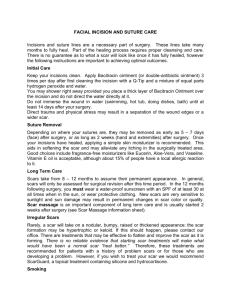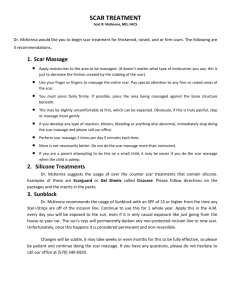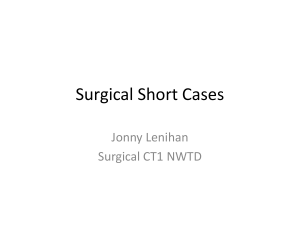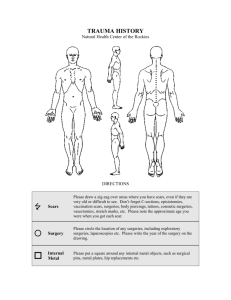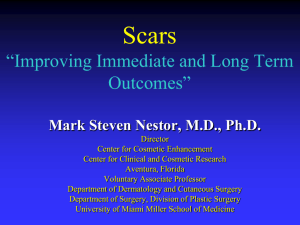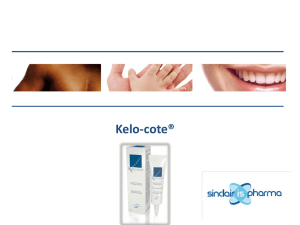Physiotherapy treatment of scars
advertisement
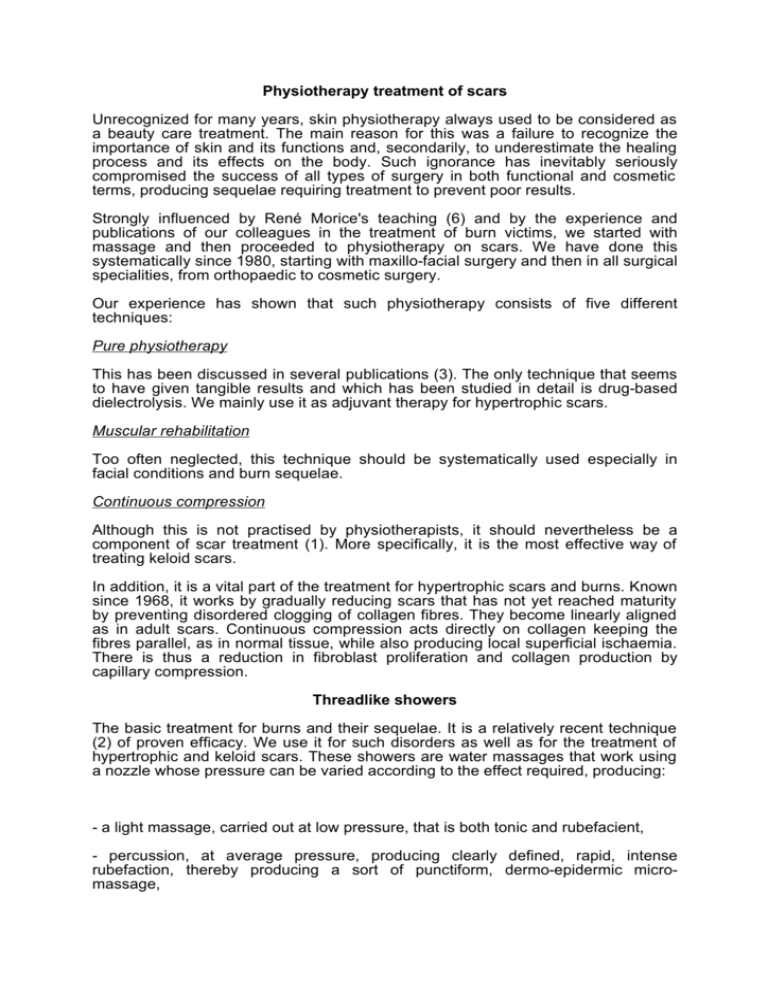
Physiotherapy treatment of scars Unrecognized for many years, skin physiotherapy always used to be considered as a beauty care treatment. The main reason for this was a failure to recognize the importance of skin and its functions and, secondarily, to underestimate the healing process and its effects on the body. Such ignorance has inevitably seriously compromised the success of all types of surgery in both functional and cosmetic terms, producing sequelae requiring treatment to prevent poor results. Strongly influenced by René Morice's teaching (6) and by the experience and publications of our colleagues in the treatment of burn victims, we started with massage and then proceeded to physiotherapy on scars. We have done this systematically since 1980, starting with maxillo-facial surgery and then in all surgical specialities, from orthopaedic to cosmetic surgery. Our experience has shown that such physiotherapy consists of five different techniques: Pure physiotherapy This has been discussed in several publications (3). The only technique that seems to have given tangible results and which has been studied in detail is drug-based dielectrolysis. We mainly use it as adjuvant therapy for hypertrophic scars. Muscular rehabilitation Too often neglected, this technique should be systematically used especially in facial conditions and burn sequelae. Continuous compression Although this is not practised by physiotherapists, it should nevertheless be a component of scar treatment (1). More specifically, it is the most effective way of treating keloid scars. In addition, it is a vital part of the treatment for hypertrophic scars and burns. Known since 1968, it works by gradually reducing scars that has not yet reached maturity by preventing disordered clogging of collagen fibres. They become linearly aligned as in adult scars. Continuous compression acts directly on collagen keeping the fibres parallel, as in normal tissue, while also producing local superficial ischaemia. There is thus a reduction in fibroblast proliferation and collagen production by capillary compression. Threadlike showers The basic treatment for burns and their sequelae. It is a relatively recent technique (2) of proven efficacy. We use it for such disorders as well as for the treatment of hypertrophic and keloid scars. These showers are water massages that work using a nozzle whose pressure can be varied according to the effect required, producing: - a light massage, carried out at low pressure, that is both tonic and rubefacient, - percussion, at average pressure, producing clearly defined, rapid, intense rubefaction, thereby producing a sort of punctiform, dermo-epidermic micromassage, - abrasion to thoroughly scrub the skin. The purpose of this procedure is to remove waste products, and it must be carried out very carefully. Threadlike showers have two effects: chemical: thorough high-pressure water penetrating into the skin, mechanical: through micro-massage producing reflex vasodilatation and longitudinal restructuring of elastic and collagen fibres. Massage It has been and continues to be the main component of both manual and mechanical massage and physiotherapy treatment of scars. In all cases we emphasize the following: functional results: avoiding retraction of both the scar itself and the surrounding tissues, and restoring normal movement in the underlying muscles to the scar. In addition, scars, particularly facial ones, produce inhibition effects, and we thus attempt to restore (as soon as possible) mobility in the affected region. circulatory results: by improving active circulation, increasing capillary permeability, stimulating lymph flow and assisting the passage of polynuclear cells cosmetic results: by promoting harmonious healing and avoiding vicious scars. Manual Lymphatic Drainage: mainly used in this type of treatment to rapidly reabsorb oedema that delays the use of special scar massage techniques, thereby compromising scar quality, rather than for removing polynuclear cells, despite this being a useful effect. The most reliable technique, alongside vacuomobilization, in terms of reducing retraction (functional results) and improving circulation (active circulation: capillary permeability) is manual massage. Inspired by the experience of R. Morice, we almost exclusively use the four following well-defined techniques (5): Jacquet-Leroy pinching plus torsion. This rapid movement is performed, using each hand alternately, by simultaneously pinching and pulling the skin between the flesh of the thumb and second finger (principle of snapping one's fingers). This technique is used in both the areas surrounding the scars and on the scar itself (pinchingtwisting). Kneading using two fingers along the whole length of the scar producing stretching in all its segments. This procedure is described as being mainly defibrotic. Palpating-rolling, which we consider should be carried out both transversally and longitudinally (in relation to the direction of the scar). For linear scars we carry out small movements, generally with two fingers. Orthodermic stretching, described by R. Morice as follows: "putting sustained pressure with the fleshy side of the fingers of each hand on the small area treated, and then stretching the skin on both sides of the starting point. This mobilisation combats retraction." In conclusion, R. Morice writes: "The immediate result of each session is congestion and a rise in temperature giving the sensation of cooking, warmth and turgescence in the skin ...". This type of treatment should be carefully carried out by a trained practitioner. Vacuomobilization: It consists of using the vacuum created (7) by suction and combining it with the efficacy of all the massage movements that we have mentioned above. It is obvious the combination of all these procedures with the vacuum produced very considerably increases both the mechanical and circulatory effects (4). In linear scars, we use a small diameter suction pad (less than 10 mm) held between the thumb and index finger, to very precisely reproduce the movements described above. The suction power is adapted to the patient's sensitivity, age of the scar, location, type and, lastly, the effect required. Palpation plus rolling is achieved when moving the suction pad by rolling the skin under the edges of it. Kneading is carried out by stretching the scar transversally with traction in the opposite direction (performed with two fingers). Pinching plus turning is carried out by applying the suction pad locally which is then lifted and twisted at the same time. Lastly, stretching can be performed through depression rather than under pressure by moving from one area to the next (as in pinching plus twisting) without sliding, and then stretching the scar tissue against the flesh of the fingers in the other hand. In conclusion, vacuomobilization undeniably increases the effect and efficacy of all these procedures, but should nevertheless always be accompanied by manual massage. It should also be carried out with great care to prevent haematoma formation. If properly carried out, vacuomobilization automatically induces significant congestion and a higher temperature than achieved with massage. It is thus undoubtedly the best technique currently available for the circulation in functional terms because of its anti-fibrotic and anti-retraction effects. This procedure should still be accompanied by other techniques, particularly massage, and reliable, precise and suitable (in terms of the intensity of depression) equipment is also required, which explains why we use Eureduc's TV 10. J.M. Hebting, MKDE, 4 bis Rue de Nozeran - 34000 Montpellier, France - O. Billottet - J.O. Bourgeois - Dr P.Y. Atlan (Maxillo-Facial Surgery Department).
